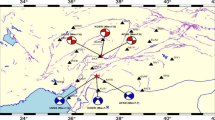Abstract
In recent decades, the space geodesy has been applied to the areas such as transportation, infrastructure planning, navigation, etc. Among them, the precise positioning at the Global Navigation Satellite System (GNSS) stations yields better view in the understanding of the crustal deformation that requires global-scale measurements. There have been numerous studies examining the data process of continuous GNSS observations in the field of earth monitoring. More recently, GNSS stations established for continuously operating reference station networks have been beneficial resources in the tectonic plate-monitoring studies in lieu of campaign-type observations. However, this requires that the Continuously Operating Reference Station (CORS) should be established on stable structures acting like foundations and requires investigation of the long-term repeatability time series. This study aims to introduce recently established national CORS network, named CORS-TR, covering the entire Turkey and Northern Cyprus, and to explain the process of the long-term data obtained from the network on the characteristics of the tectonic plate movement within the area. The results of the CORS-TR data process present a great potential of using continuously operating reference stations not only in real-time kinematic applications of conventional geodesy studies but also in detecting and monitoring the crustal deformations of those that are crucial in earthquake-prone areas like Turkey. Since the findings are computed from the results of the all permanent stations of CORS-TR network, this study also examines the GNSS observation quality of the network for the given time interval. One of the major conclusions of the data process conducted in the study displays that the CORS-TR stations established on the carefully selected large and low-rise existing building had been more stable than the stations on the ground which have been subjected to soil settlement since the construction.











Similar content being viewed by others
References
Eren K, Uzel T, Gülal E, Yildirim Ö, Cingöz A (2009) Results from a comprehensive Global Navigation Satellite System test in the CORS-TR network: case study. J Surv Eng 135(1):10–18
Gross RS, Blewitt G, Clarke PJ, Lavallée D (2004) Degree-2 harmonics of the Earth’s mass load estimated from GPS and Earth rotation data. Geophys Res Lett 31:L07601. doi:10.1029/2004GL019589
Herring TA, King RW, McClusky S (2009a) GAMIT reference manual 10.3. Massachusetts Institute of Technology, USA
Herring TA, King RW, McKlusky SC (2009b) GLOBK reference manual: global Kalman filter VLBI and GPS analysis program, version 10.35. Massachusetts Institute of Technology, Cambridge
Kinlyside D (2006) Sydney project. Land & Property Information Division Department of Lands, Bathurst
Lachapelle G, Fortes LP, Cannon ME, Alves P, Townsend B (2001) “RTK accuracy enhancements with a reference networkbased approach.” 3rd Int. Symp. on Mobile Mapping Technology (CD-ROM)
Le Pichon X, Angelier J (1979) The Aegean arc and trench system: a key to the neotectonic evolution of the eastern Mediterranean area. Tectonophysics 60:1–42
Le Pichon X, Kreemer C (2010) The Miocene-to-present kinematic evolution of the eastern Mediterranean and Middle East and its implications for dynamics. Annu Rev Earth Planetary Sci 38:323–351
McClusky S, Balassanian S, Barka A, Demir C, Ergintav S, Georgiev I, Gurkan O, Hamburger M, Hurst K, Kahle H, Kastens K, Kekelidze G, King R, Kotzev V, Lenk O, Mahmoud S, Mishin A, Nadriya M, Ouzounis A, Paradissis D, Peter Y, Prilepin M, Reilinger R, Sanli I, Seeger H, Tealeb A, Toksoz MN, Veis G (2000) Global Positioning System constraints on plate kinematics and dynamics in the eastern Mediterranean and Caucasus. J Geophys Res 105:5695–5719
McKenzie DP (1978) Active tectonics of the Alpine-Himalayan belt: the Aegean Sea and surrounding regions. Geophys J R Astron Soc 55:217–254
Santala J, Tötterström S (2002) On testing of RTK-network virtual concept. FIG XXII Int. Congress
Author information
Authors and Affiliations
Corresponding author
Rights and permissions
About this article
Cite this article
Uzel, T., Eren, K., Gulal, E. et al. Monitoring the tectonic plate movements in Turkey based on the national continuous GNSS network. Arab J Geosci 6, 3573–3580 (2013). https://doi.org/10.1007/s12517-012-0631-5
Received:
Accepted:
Published:
Issue Date:
DOI: https://doi.org/10.1007/s12517-012-0631-5




